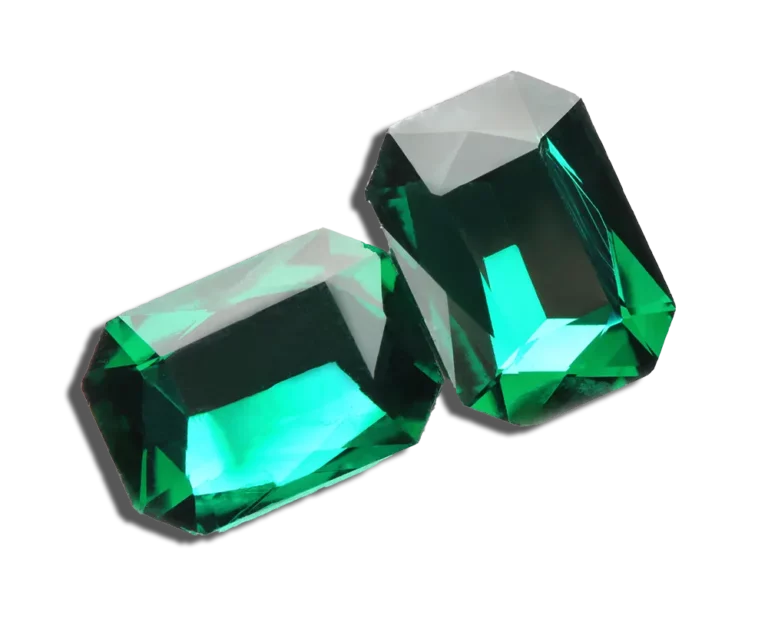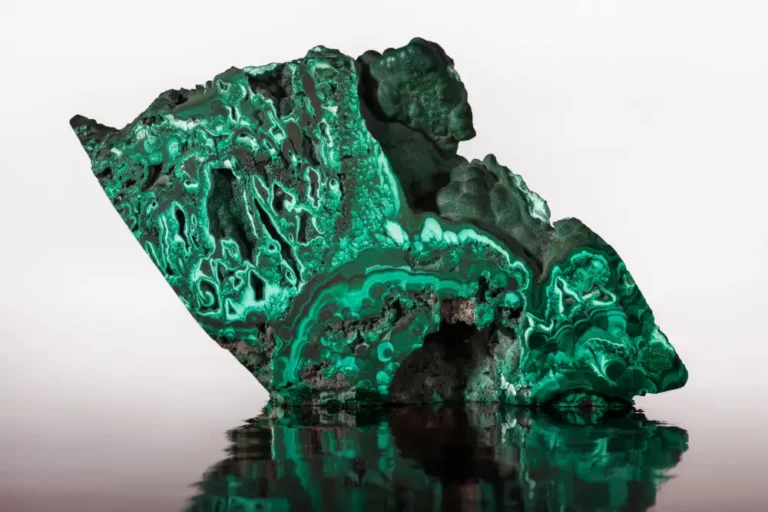The Enthralling Story of the Logan Sapphire: A Gemological Marvel
The Logan Sapphire is a fascinating gemological wonder that has captivated audiences around the world. This magnificent gemstone is notable for its exceptional size, captivating color, and intriguing history. Named after its last private owner, Mrs. Rebecca Pollard Guggenheim Logan, the Logan Sapphire is considered one of the world’s largest and finest quality sapphires, and it certainly carries an allure that compares with the world’s most celebrated gemstones.
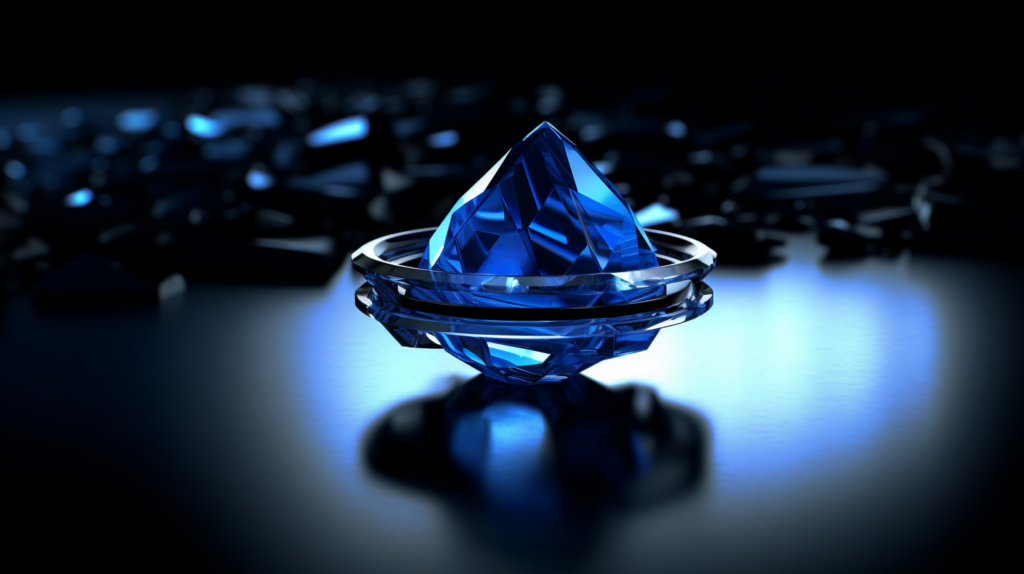
In This Article
The Astounding Size, Weight, and Cut of the Logan Sapphire
Weighing a staggering 422.99 carats, the Logan Sapphire is a true marvel. It is not just its size that is awe-inspiring, but also the remarkable cut of the gemstone. The sapphire is cushion-shaped and set in a brooch surrounded by twenty round brilliant-cut diamonds that weigh approximately 16 carats. This exceptional cut enhances the gemstone’s brilliance and maximizes the light return significantly, contributing to its much-vaunted beauty.
The Natural Color, Fluorescence and Inclusions of the Logan Sapphire
The Logan Sapphire is renowned for its striking deep blue color, a characteristic that is highly sought after in gemstones. The remarkable hue of the stone is attributed to the presence of iron and titanium within its crystal structure. Moreover, the sapphire exhibits a fascinating attribute known as fluorescence which, when exposed to UV light, gives the stone a slightly different color, further increasing its appeal. The Logan Sapphire, while not completely flawless, has relatively few inclusions, making it an extremely high-quality gem.
The Logan Sapphire: A Sri Lankan Treasure
Sri Lanka: The Origin of the Logan Sapphire

The origin of this gemological marvel can be traced back to the beautiful island of Sri Lanka. Known historically as the “Gem Island”, Sri Lanka boasts a vast mineral wealth and is a significant source of high-quality sapphires in the world. The country’s rich gemological heritage and favorable geological conditions contribute to producing sapphires like the Logan Sapphire that are coveted globally.
Ratnapura: The Possible City of Origin for the Logan Sapphire
Many believe that the Logan Sapphire was mined from the city of Ratnapura, meaning “City of Gems” in the local Sinhalese language. This city lies in the heart of the Sri Lankan gem mining region and is globally recognized for its high-quality sapphires. Ratnapura’s gem mining industry is characterized by its traditional, small-scale operations, which have helped to preserve this rich part of Sri Lanka’s cultural heritage.
Mining and Sourcing of Sapphires in Sri Lanka
Gem mining in Sri Lanka is a centuries-old tradition, with many mines still using age-old techniques. The journey of a Sapphire from the earth to a gemstone is mesmerizing. The miners first excavate the gem-bearing gravel, known locally as “illam”. This is then washed and sieved to reveal the precious stones hidden within. The careful sourcing and expert handling of these resources ensure that the mined sapphires, like the Logan Sapphire, reach their full potential in terms of quality and beauty.
The Journey of the Logan Sapphire
Ownership History: From Sir Victor Sassoon to Rebecca Pollard Guggenheim

The journey of the Logan Sapphire is as riveting as its sparkling blue hue. Believed to have been acquired by Sir Victor Sassoon, a prominent British businessman with a keen interest in gemstones, the sapphire was then passed to his relative, Mrs. Rebecca Pollard Guggenheim. The gem not only changed hands but also continents, travelling from Asia to Europe, and finally, to America.
Significance of the Blue Sapphire in the Sassoon Family
The blue sapphire held a special place in the Sassoon family, symbolizing wisdom, virtue, and good fortune. Its mesmerizing deep blue color was admired and treasured by the family, which might be one reason why they chose to include such a remarkable sapphire in their collection.
The Logan Sapphire: A Gift from M. Robert Guggenheim
Mrs. Rebecca Pollard Guggenheim received this magnificent gem as a gift from her husband, M. Robert Guggenheim, an affluent American businessman and philanthropist. It was an extraordinary token of love, underlining the romantic and personal nature of gem-giving.
Rebecca’s Response: From Guggenheim to Logan
After her husband’s death and her subsequent remarriage, Mrs. Guggenheim adopted her second husband’s surname, hence giving the iconic gemstone its current name – the Logan Sapphire.
In the following years, the Logan Sapphire continued to enamour everyone with its fascinating allure, contributing significantly to its reputation as a gemological phenomenon.
The Logan Sapphire’s Donation to the Smithsonian Institution
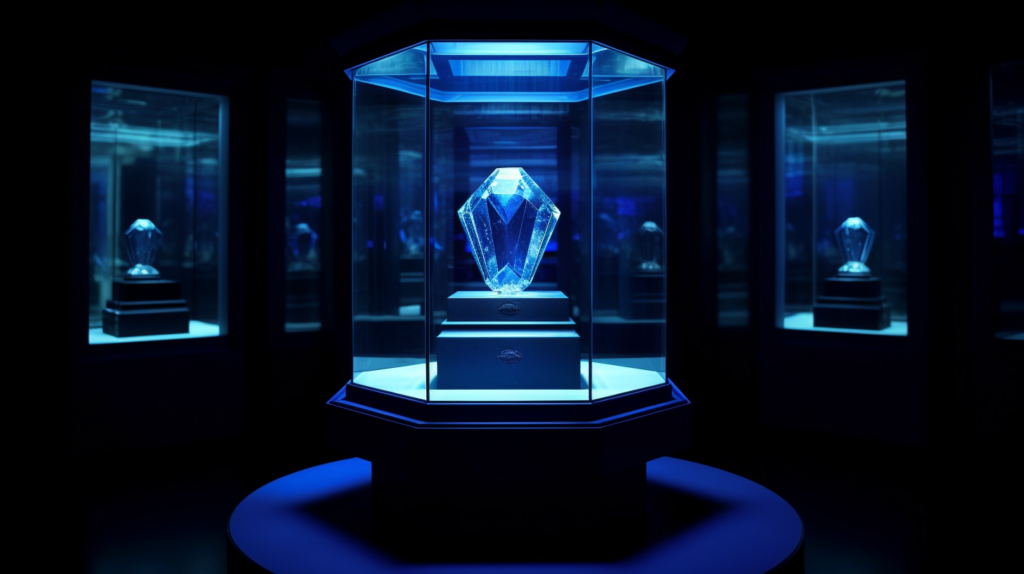
The Role of Philanthropy in Acquiring the Logan Sapphire
The story of the Logan Sapphire doesn’t end with its acquisition by Mrs. Logan. Instead, it took an unexpected turn when she decided to donate this gemological marvel to the Smithsonian Institution in 1960. This act of philanthropy expanded the gem’s audience, allowing millions of visitors to admire this remarkable gemstone.
Rebecca Logan’s Decision to Donate the Sapphire
Mrs. Logan’s decision to donate the sapphire was driven by her desire to share the beauty of the gem with the public. She believed that the sapphire, with its rich history and exquisite characteristics, deserved to be admired by more than just a select few. Moreover, she was aware that her donation would significantly enhance the Smithsonian’s gem collection and contribute to their educational mission.
The Logan Sapphire’s Place in the Smithsonian Institution
Today, the Logan Sapphire graces the Janet Annenberg Hooker Hall of Geology, Gems, and Minerals at the National Museum of Natural History in Washington, D.C. It is one of the main attractions in the museum’s gem collection, drawing visitors from across the globe. Displayed in a necklace of 20 large round brilliant-cut diamonds, the Logan Sapphire continues to captivate audiences with its mesmerizing hue and impressive size.
The Logan Sapphire: A Gemological Phenomenon
The Logan Sapphire’s Impact on Gemology and Jewelry Design
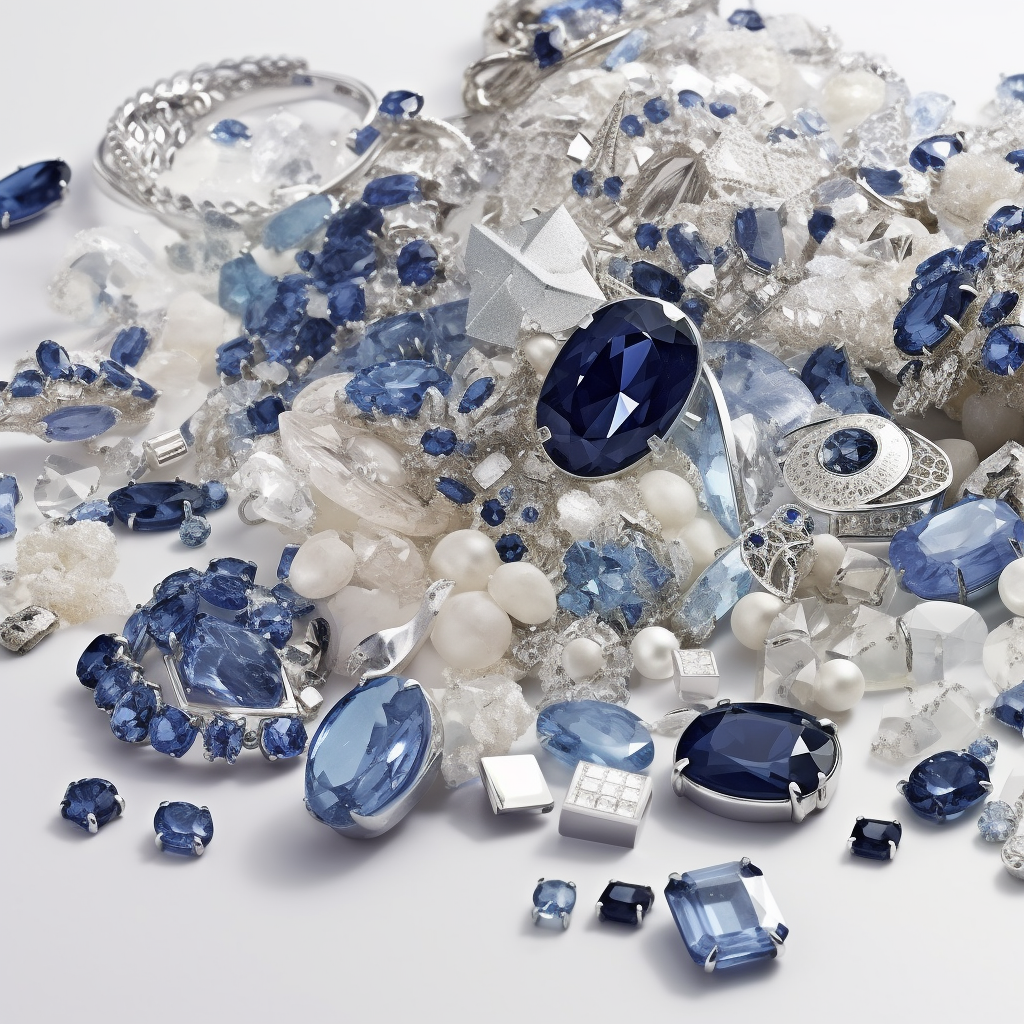
The Logan Sapphire has left an indelible mark on the world of gemology and jewelry design. Its staggering size, enthralling color, and nearly flawless clarity set a high bar for other gemstones. It’s a testament to nature’s capacity to create incredible beauty, and it continues to inspire gemologists and jewelry designers worldwide.
The Sapphire’s Role in the Gemological Institute of America
The Logan Sapphire has played a significant role in the Gemological Institute of America‘s (GIA) studies. Its impressive characteristics provide a benchmark for evaluating the quality of other sapphires. The GIA often refers to the Logan Sapphire to demonstrate the optimum color, clarity, and size that sapphires can achieve.
A Comparison with Other Notable Sapphires
When compared to other celebrated sapphires, the Logan Sapphire still holds its own. While the Blue Belle of Asia and the Star of India are renowned for their unique attributes, the Logan Sapphire’s incomparable size, striking blue color, and fascinating history make it stand out. It is an apt representative of Sri Lanka’s gemological treasures on the global stage.
The Logan Sapphire: A Symbol of Cultural Significance
The Historical and Cultural Significance of Sapphires in Sri Lanka
In Sri Lanka, the birthplace of the Logan Sapphire, sapphires hold a special place in history and culture. The country, with its rich deposits of gems, has long been associated with the mining and crafting of exquisite sapphires. Folklore and legends surrounding these precious gemstones have been passed down through generations, with sapphires believed to bring protection, wisdom, and good fortune. The Logan Sapphire, a product of this gem-rich country, is a symbol of Sri Lanka’s heritage and its centuries-old connection to these beautiful blue stones.
The Symbolism and Meaning of Blue Sapphires in Different Cultures
Across different cultures, the blue sapphire is revered and associated with divine favor, wisdom, and nobility. In ancient Greece and Rome, rulers believed that blue sapphires protected their wearers from harm and envy. In the Middle Ages, clergy wore blue sapphires to symbolize heaven. In many cultures, the blue sapphire’s heavenly hue symbolizes truth, faithfulness, and nobility. Today, it remains popular in bridal jewelry, often symbolizing fidelity in love. The Logan Sapphire, with its captivating depth of color and enormity, embodies all these qualities and symbolizes the timeless allure of blue sapphires.
The Logan Sapphire: A Crowning Jewel in Personal Style
The Sapphire Brooch: A Statement of Style
Sapphires have always made a bold statement in the realm of personal style. The Logan Sapphire, set in a brooch surrounded by brilliant-cut diamonds, is a testament to this. This striking piece of jewelry not only showcases the sapphire’s remarkable beauty and size but also adds an element of sophistication and class to any attire. It exhibits a timeless design, highlighting that elegance and style need not be ostentatious but can lie in simplicity and sophistication.
The Influence of the Logan Sapphire on Contemporary Jewelry Design
The Logan Sapphire has played a significant role in influencing contemporary jewelry design. Its unique cushion cut and the simplistic yet elegant setting have inspired numerous jewelers to design pieces that highlight the gemstone’s natural beauty. Today, the combination of blue sapphires with diamonds is a popular trend in jewelry design, which can be attributed, at least in part, to the enduring influence of the Logan Sapphire. It serves as a benchmark for high-quality, elegantly designed sapphire jewelry, proving that the allure of a large, beautifully cut and colored sapphire is timeless.
Conclusion: The Enduring Legacy of the Logan Sapphire
The Logan Sapphire: A Testament to Sri Lanka’s Gemological Riches
The Logan Sapphire is a remarkable representation of Sri Lanka’s gemological wealth. This magnificent gemstone, with its awe-inspiring size, entrancing color, and almost flawless clarity, attests to the gem-rich soil of this island nation. It symbolizes the skill and expertise of the miners and gem cutters of Sri Lanka, whose labor brings such beauty to the surface.
The Sapphire’s Ongoing Display at the National Museum of Natural History
On display at the National Museum of Natural History, the Logan Sapphire continues to captivate audiences with its impressive characteristics and fascinating history. As visitors marvel at its beauty, its story unfolds – a story that involves many hands and travels across continents, ultimately culminating in a generous act of donation that allows the world to share in its beauty.
Reflection on the Logan Sapphire’s Significance in the World of Gems
The Logan Sapphire holds a significant place in the world of gemology. It serves as a benchmark for evaluating the quality of other sapphires, inspiring gemologists and jewelry designers worldwide. Alongside its gemological significance, it carries a cultural weight, reflecting Sri Lanka’s rich history and tradition connected with gem mining and sapphires. While it may just be a gemstone to some, the Logan Sapphire is undoubtedly a marvel, a testament to nature’s beauty, and a symbol of cultural heritage and personal style. Its legacy continues to endure, ensuring its place as one of the world’s most celebrated gemstones.
Frequently Asked Questions (FAQs)
What is the Logan Sapphire and why is it significant?
The Logan Sapphire is one of the largest known faceted blue sapphires in the world. Its significant size, weight, natural color, and astounding cut make it a marvel in the gemological world. Its origin from Sri Lanka and historical journey through various owners add to its allure.
Where did the Logan Sapphire originate from?
The Logan Sapphire is believed to have originated from Sri Lanka, specifically the city of Ratnapura, which is famous for its gem mines.
Who were the notable owners of the Logan Sapphire before its donation to the Smithsonian Institution?
The Logan Sapphire was initially owned by Sir Victor Sassoon of the notable Sassoon family. It was later gifted to Rebecca Pollard Guggenheim by her husband M. Robert Guggenheim. Later, Rebecca adopted her maiden name, Logan, and was known as the last private owner of the Sapphire.
Why was the Logan Sapphire donated to the Smithsonian Institution?
The Logan Sapphire was donated to the Smithsonian Institution as a philanthropic gesture by Rebecca Logan. The sapphire is now a significant part of the museum’s gem and mineral collections, recognized by visitors from around the world.
How has the Logan Sapphire influenced contemporary jewelry design?
As one of the iconic gems in history, the Logan Sapphire has greatly influenced contemporary jewelry design. Its size, cut, and color have set standards for what a high-quality sapphire should look like. Furthermore, its use as a brooch reflects its role in personal style and statement-making jewelry.



